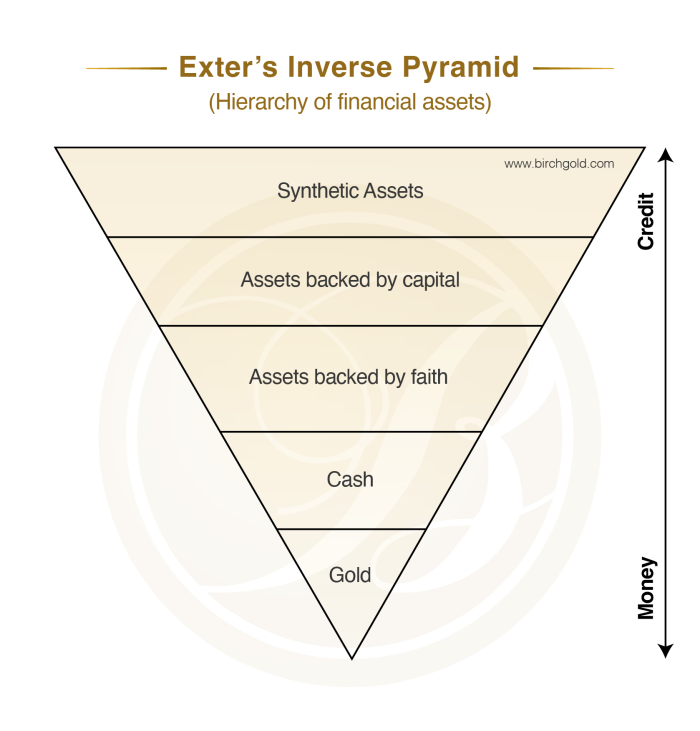
Right now, one thing that seems to be in short supply is trust.
 Bullion.Directory precious metals analysis 17 May, 2024
Bullion.Directory precious metals analysis 17 May, 2024
By Peter Reagan
Financial Market Strategist at Birch Gold Group
Almost no one in their right mind trusts what is going on in today’s chaotic economy. The bad thing about this lack of trust? Most of the global financial system is based on it.
For example, here in the U.S., the Federal Reserve, Treasury and the White House are supposed to preserve that trust when it comes to handling the country’s debt. Right now, they aren’t doing such a good job (especially geopolitically). That devalues the dollar and, as a result, accelerates inflation.
Here’s another example: China’s enduring a real estate meltdown right now – mostly because investors handed real estate developers hundreds of billions in downpayments for new construction real estate… Most of which is now half-constructed and fully abandoned. Overall property values were down 33% as of January.

The half-completed, vacant Jinguang East Coast International Apartments development in Liaoning, China. © CEphoto, Uwe Aranas / CC-BY-SA-3.0
The point I’m making here is that most financial transactions are based on trust! Debts are a promise to pay – you trust the promise. A deposit on a condo is a promise to deliver a finished condo! What happens when the developer goes bankrupt?
When trust vanishes, what are you left with?
That’s a very good question…
Introducing non-debt money
Billionaire hedge fund executive Ray Dalio recently asked an important question: Do you have enough non-debt money?
After explaining why pretty much every form of currency is “debt money,” he went on to explain why gold fits the definition of “non-debt” money:
Gold, on the other hand, is a non-debt-backed form of money. It’s like cash, except unlike cash and bonds, which are devalued by risks of default or inflation, gold is supported by risks of debt defaults and inflation. It is held by central banks and other investors for this reason. In fact, gold is the third-most-held reserve currency by central banks, more so than the [Japanese] yen or [China’s] renminbi.
Put simply, gold is one form of “non-debt” money that is supported during our current “trustless economy.”
To further show why this is the case, we will look to John Exter. He was a member of the Board of Governors of the Federal Reserve, and developed a concept known as “Exeter’s Pyramid.”
Many versions of this pyramid have been visualized over the years (here’s an example) but they all share one thing in common: The higher you climb up the pyramid, the less an asset’s value is tied to reality.
Here is my simplified version of Exeter’s pyramid, showing us the global economy from top to bottom.

I use “notional value” to indicate the approximate total dollar value for each category below – it’s “notional” because if anyone tried to liquidate an entire class of assets, prices would plummet… So we’re using “notional value” to indicate the relative sizes of these different levels of the pyramid.
Here’s what each category means:
- Synthetic assets are purely financial “assets” based on price movements of an underlying asset. You’ve heard of credit default swaps and zero-day expiration options and so on. They’re essentially a side bet on an asset (and, one could argue, completely imaginary). Notional value: $715 trillion.
- Faith-backed assets are promises to pay from corporations and government entities. Notional value: $315 trillion.
- Capital-backed assets have some underlying value based on fixed capital (think factories, heavy equipment, real estate etc.) They’re mostly priced based on expected future cash flows, rather than the actual value of underlying assets – currently, worldwide, $1 in capital costs $1.35-$11. (Yes, some people pay as much as $11 for a single dollar’s worth of value!) Notional value: $111 trillion.
- Cash is an asset which is of course, a tangible asset, but purchasing power hasn’t been doing so hot thanks in part to inflation. Notional value: $104 trillion.
- Physical gold is another tangible asset, with virtually guaranteed purchasing power thanks to its ability to act as a store of value over thousands of years. Value: $16 trillion.
But there are also at least three other ways to compare gold with the assets it supports on Exeter’s pyramid:
- Every asset on the pyramid except gold can be defaulted on. They’re essentially promises to pay.
- All assets on the pyramid bear counterparty risk. Gold has zero counterparty risk.
- All assets are based on a promise of value, which requires trust. A promise to pay in a currency that can be printed (U.S. dollars for example) is not a particularly reliable promise to deliver value! Gold has been the most trusted asset for thousands of years, in part because it cannot be printed into existence.
The “non-debt” strength of gold is further demonstrated when things are chaotic in the global economy. An article on ZeroHedge illustrates just one example of this:
But gold’s share of total reserves is presently on the rise, for one because trust in dollars is eroding due to the freezing of Russian assets worth $300 billion since the war in Ukraine that started in 2022. Second, the United States’ public debt is spiraling out of control while the Federal Reserve can’t get inflation tamed. Central banks are currently buying record amounts of gold and driving up the price.
It’s pretty easy to conclude that central banks are seeking stability, and are buying gold to help stabilize their asset mix.
The good news is, you can follow their lead…
Stabilize your financial future with a solid foundation
As the world goes deeper into debt, and in the future, if households start to run out of cash in a “trustless” economy…
Then any “synthetic” assets that only fluctuate in value based on speculation could start losing their value. That also means tangible assets you can hold in your hand could become increasingly more important.
The fact that global central banks set a new record for Q1 purchases of physical gold could be a signal that times are changing in that direction:
Central bank net demand totaled 290 metric tons in Q1 – the strongest start to any year on record
In what was an interesting quarter for the gold market, central banks made clear their commitment to the longstanding trend of gold buying. While the recent price rally may have impacted trade execution, for those central banks that manage their gold reserves more actively, we do not expect it will derail any strategic gold accumulation plans they may have.
Keeping everything mentioned above in mind, perhaps it’s time for you to consider following the smart money.
Here’s how to get started…
Properly diversify into precious metals like gold and silver. If you already have some, now is a great time to consider increasing your holdings.
Here’s why: The combination of record demand from central banks and private investors like you have already started pushing prices up fast.
You can start learning more about the advantages of diversifying with physical precious metals like gold and silver right here.
Peter Reagan

Peter Reagan is a financial market strategist at Birch Gold Group, one of America’s leading precious metals dealers, specializing in providing gold IRAs and retirement-focused precious metals portfolios.
Peter’s in-depth analysis and commentary is published across major investment portals, news channels, popular US conservative websites and most frequently on Birch Gold Group’s own website.
This article was originally published here











 Material provided on the Bullion.Directory website is strictly for informational purposes only. The content is developed from sources believed to be providing accurate information. No information on this website is intended as investment, tax or legal advice and must not be relied upon as such. Please consult legal or tax professionals for specific information regarding your individual situation. Precious metals carry risk and investors requiring advice should always consult a properly qualified advisor. Bullion.Directory, it's staff or affiliates do not accept any liability for loss, damages, or loss of profit resulting from readers investment decisions.
Material provided on the Bullion.Directory website is strictly for informational purposes only. The content is developed from sources believed to be providing accurate information. No information on this website is intended as investment, tax or legal advice and must not be relied upon as such. Please consult legal or tax professionals for specific information regarding your individual situation. Precious metals carry risk and investors requiring advice should always consult a properly qualified advisor. Bullion.Directory, it's staff or affiliates do not accept any liability for loss, damages, or loss of profit resulting from readers investment decisions.

Leave a Reply